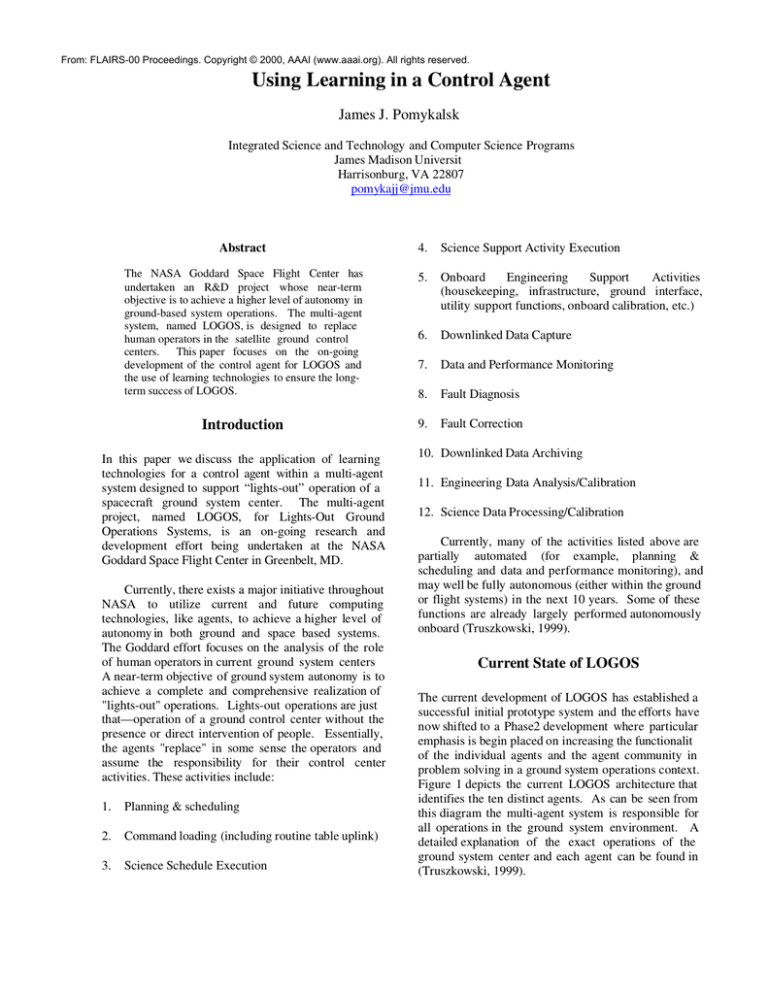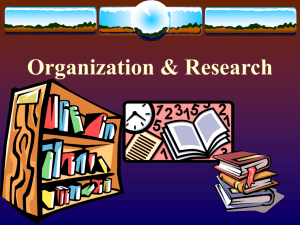
From: FLAIRS-00 Proceedings. Copyright © 2000, AAAI (www.aaai.org). All rights reserved.
Using Learning in a Control Agent
James J. Pomykalsk
Integrated Science and Technology and Computer Science Programs
James Madison Universit
Harrisonburg, VA 22807
pomykajj@jmu.edu
Abstract
4.
Science Support Activity Execution
The NASA Goddard Space Flight Center has
undertaken an R&D project whose near-term
objective is to achieve a higher level of autonomy in
ground-based system operations. The multi-agent
system, named LOGOS, is designed to replace
human operators in the satellite ground control
centers. This paper focuses on the on-going
development of the control agent for LOGOS and
the use of learning technologies to ensure the longterm success of LOGOS.
5.
Onboard
Engineering
Support
Activities
(housekeeping, infrastructure, ground interface,
utility support functions, onboard calibration, etc.)
6.
Downlinked Data Capture
7.
Data and Performance Monitoring
8.
Fault Diagnosis
Introduction
9.
Fault Correction
In this paper we discuss the application of learning
technologies for a control agent within a multi-agent
system designed to support “lights-out” operation of a
spacecraft ground system center. The multi-agent
project, named LOGOS, for Lights-Out Ground
Operations Systems, is an on-going research and
development effort being undertaken at the NASA
Goddard Space Flight Center in Greenbelt, MD.
Currently, there exists a major initiative throughout
NASA to utilize current and future computing
technologies, like agents, to achieve a higher level of
autonomy in both ground and space based systems.
The Goddard effort focuses on the analysis of the role
of human operators in current ground system centers
A near-term objective of ground system autonomy is to
achieve a complete and comprehensive realization of
"lights-out" operations. Lights-out operations are just
that—operation of a ground control center without the
presence or direct intervention of people. Essentially,
the agents "replace" in some sense the operators and
assume the responsibility for their control center
activities. These activities include:
1.
Planning & scheduling
2.
Command loading (including routine table uplink)
3.
Science Schedule Execution
10. Downlinked Data Archiving
11. Engineering Data Analysis/Calibration
12. Science Data Processing/Calibration
Currently, many of the activities listed above are
partially automated (for example, planning &
scheduling and data and performance monitoring), and
may well be fully autonomous (either within the ground
or flight systems) in the next 10 years. Some of these
functions are already largely performed autonomously
onboard (Truszkowski, 1999).
Current State of LOGOS
The current development of LOGOS has established a
successful initial prototype system and the efforts have
now shifted to a Phase2 development where particular
emphasis is begin placed on increasing the functionalit
of the individual agents and the agent community in
problem solving in a ground system operations context.
Figure 1 depicts the current LOGOS architecture that
identifies the ten distinct agents. As can be seen from
this diagram the multi-agent system is responsible for
all operations in the ground system environment. A
detailed explanation of the exact operations of the
ground system center and each agent can be found in
(Truszkowski, 1999).
S/C
Spacecraft Dataserver
Paging
System
TPOCC
Archive
Alertsystem
AGENTPOOL
Telemetry
Pass
automation
Pass
planning
TPOCC
Server
GENSAA/
GENIE
MOPSS
System
Management
Agent
GENSAA/
GENIE
I / FAgent
MOPSS
I/F
Agent
=External System
Beeper
Alert / Ack.
Pager
Agent
Other
Agent(s)
FIRE
Agent
USER
I / FAgent
Database
Agent
ArchiveIF
Agent
WEB
USER
GisA
V
SDG
VE
I / FAgent
VisAGE
Archive
Datavisualizations
=Agent
Figure 1: LOGOS (Phase1 Architecture)
One important characterization that can be made
about the ten agents within LOGOS is a separation of
the agents by their main type of behavior. Table 1
shows the ten named agents and their particular
categorization as either reactive or deliberative agents.
Reactive Agents
Archive Interface Agent
Database Interface
Agent
GenSAA Interface
Agent
Log Agent
Deliberative Agents
FIRE Agent
User Interface Agent
VisAGE Interface
Agent
System Management
and Monitoring Agent
Pager Agent
MOPSS Agent
with one another to solve problems that singular,
monolithic systems can not solve due to complexity.
The advent of agent-based programming and systems
development utilizes the distributed, networked nature
of many problems or organizations and attempts to
mimic group problem-solving behavior.
Man
advantages have been attributed to multi-agent systems,
but the goal is to produce “communities” of problemsolving entities that are adaptable, flexible, “robust”,
and eventually creative, in solving large complex
problems. A “robust” agent is defined as an agent that
has the ability to reason in a deliberative and/or social
fashion, plan, schedule, model the environment, and
learn (Truszkowski, 1999).
In order for these multi-agent systems to be
adaptable and robust, the community of agents, as well
as the agents themselves, must have to ability to gain
knowledge from their experiences in solving problems.
Learning can be thought of as the process of translating
(or transforming) observations or experience into
knowledge to be stored in a form suitable for use
whenever needed (Fabris, 1998). To date, many
different learning techniques have been developed and
implemented; see (Honavar, 1994) for more details.
SysMMA: The Control Agent
The
System
Management/Monitoring Agent
(SysMMA) is responsible for monitoring and managing
all agents in LOGOS and serves as the main control
agent within LOGOS. In the initial LOGOS prototype,
SysMMA fulfilled the following requirements:
1.
Cataloged information on each registered agent in
the Agent Registry file. The same Registry is also
used to provide, upon request, the capabilities of
agents that exist within the system as well as the
name/location of the agent that is able to perform
the requested function.
2.
Acted as an agent Health and Safety Monitor.
SysMMA kept track of agent status by subscribing
to the status update publication in Workplace.
Workplace is the name given to the overall system
environment that the LOGOS prototype was
developed within. This environment provided the
basic message passing protocols for the multi-agent
system.
3.
Had responsibility for sending begin-activit
warning messages before the spacecraft pass
contact starts. SysMMA did this by querying the
MOPSS Interface Agent (MIFA) for the latest
schedule information and keeping track of any new
Table 1: Classification of LOGOS Agents
Each of these agents has a distinct functionalit
within the lights-out ground operations context. One
method that has been proposed for increasing the agent
functionality, particularly the deliberative agents, is to
incorporate various learning technologies. The focus of
this paper is on the on-going development of the
System Management and Monitoring Agent (SysMMA)
and the design and use of specific learning technologies
within this agent for the long-term success of LOGOS.
Why Learning?
Multi-agent systems are a combination of
heterogeneous computing elements that are fashioned
together with the intention of being able to cooperate
schedule updates. SysMMA also sent an end-of
activity message at the end of the spacecraft pass
contact.
In fulfilling these requirements, SysMMA acted as
the system’s Yellow Pages agent and was responsible
for monitoring and managing all agents in the system.
It received registration messages from LOGOS agents
upon the agent’s initialization. This message includes
the agent’s name, its capabilities, initial status and
location. SysMMA also indirectly monitored the
agents’ health and activities by subscribing to the
WorkPlace’s status publication services, and
occasionally polls the agent to determine its latest
status. The agents’ status and capabilities information
is stored in Agent Registry and is used by SysMMA to
provide replies to LOGOS agent services requests.
SysMMA was also responsible for some event
timing, task completion and resource utilization
management. It kept track of the latest spacecraft
schedule information and sent warning messages to all
agents in LOGOS several minutes prior to the start of a
spacecraft “pass”, thereby giving agents enough time to
finish up any “unimportant” task and get ready for the
pass. A spacecraft “pass” is defined as the time interval
in which the ground station has the ability to
communicate with the spacecraft and visa versa.
SysMMA also broadcasts end of pass message
upon the reception of LOSS_OF_SIGNAL to inform
the agents to stand down from a spacecraft pass.
Finally, SysMMA also kept an up-to-date activit
record of each agent. The major deficiency of
SysMMA in Phase1 was that the agent lacked the
capability to learn.
In the future the role of SysMMA will be
expanded. Not only will SysMMA, or a small subagent of SysMMA, handle the duties outlined above,
but SysMMA must be able to manage (in a near realtime environment):
1.
the system utilization of resources available to
LOGOS,
2.
the completion of tasks by individual agents, and,
3.
most importantly, the overall missions completion
for the spacecraft pass.
This functionality is summarized by the following
future requirements (NASA GSFC, 1999):
1.
SysMMA will be able to start/stop other agents in
the system,
2.
SysMMA will be able to poll an agent’s latest
status without having to wait for an update
message, or, if the agent was not heard from for a
certain amount of time,
3.
SysMMA will be able shutdown/restart an agent
based on system status or when SysMMA ha
determined that an agent has stopped responding to
ACL messages, and
4.
Event level monitoring will be implemented.
SysMMA will be able to “recommend” actions to
the agents according to the global performance
goals of the LOGOS system.
Given this great level of responsibility and
importance within LOGOS, SysMMA must be able to
recognize trends in task completion and resource
utilization to anticipate potential work slowdowns o
bottlenecks in performing spacecraft monitoring.
Learning in SysMMA
There are many learning techniques that could be
incorporated into SysMMA to aid in its problem
solving activities within LOGOS.
These techniques include case-based reasoning,
neural networks, statistical pattern recognition, genetic
algorithms, and reinforcement learning. An essential
element to the development of learning within
SysMMA, and other agents within LOGOS, is the
application of the “correct” learning components or
processes. In addition, each of the heterogeneous
learning technologies (in terms of their knowledge
representation) must be able to share their increased
knowledge with other parts of the agent and the
remainder of the community. We do not address this
issue in this paper. Next, however, we will examine
each learning technology in light of the future
requirements of SysMMA.
The need to start/stop individual agents is to allo
for: (1) the readying agents prior to their actual usage
(this allows some agents to “sleep” during a system
pass), (2) the efficient utilization of system resources
and (3) to ensure that agents are performing their tasks
in a timely manner. Case-based reasoning (CBR
techniques can be utilized to aid in this task. For
example, SysMMA can recognize a situation (i.e., case)
when greater levels of expertise are needed to identif
and resolve anomalies. In this case, the FIRE agent
could be started and queried for input into the anomal
resolution. If, after some processing time has passed,
the SysMMA agent could recognize (again using CBR)
to start a Pager Agent which is used to summon a
human expert to help solve the anomaly not handled b
the lights-out system.
Since SysMMA is ultimately responsible for the
health and safety of the agent community, all agent
must be functioning and performing their assigned tasks
within interruption. However, situations occur when
various system resources become unavailable and must
be restarted in order to ensure the completion of the
overall mission. In the current Phase1 development,
the SysMMA agent would periodically “ping” each of
the agents within the system to ensure that they were
still on-line. This was a waste of system resources. In
future versions, other methods to ensure the health of
the agents must be derived. One such method involves
the monitoring of task completion at the agent level and
the estimation of the time to completion of various
tasks. This type of knowledge could be learned by
SysMMA through the use of statistical pattern
recognition and neural network techniques. For
example, if a particular task an agent had undertake
was normally estimated (found through statistical
studies) to take X±Y minutes and the agent had not
completed the task after Z minutes (where Z is greater
than X±Y) than the agent could use a trained neural
network to determine if an action against that agent
should be undertaken. By training a neural network to
understand if the behavior exhibited by the agent was
within “normal operational conditions” excess
“pinging” of the agent could be avoided.
The ultimate goal of the LOGOS system is to
“replace the human operators” that currently monitors
the health and safety of the spacecraft. The degree to
which LOGOS can perform to the level of expertise of
the human beings will be the ultimate standard against
which it is judged.
While each agent, by definition, is autonomous
(Truszkowski, 1999), the actions of the agents must be
coordinated with the rest of the community in order to
achieve a high degree of success with regard to th
overall mission. SysMMA will have responsibly fo
the monitoring the actions of the agents (both present
and future planned actions) and must be able to judge
which actions are meaningful in regard to fulfillment of
the mission. This requires SysMMA to formulate a
high level plan and to assign the plan activities (i.e.,
sub-goals) to the agents most capable of handling those
activities. Also, SysMMA must ensure that those
activities are being carried out. Each agent will have
the ability (if necessary) to formulate plans and to
recognize when plans are going to fail, however, it is
the responsibility of the SysMMA agent to match the
sub-goals with the particular capabilities of the agent
in an efficient and effective manner.
The use of case-based planning techniques, neural
network technologies, and/or genetic algorithms could
be utilized to ensure that the sub-goals are properl
distributed among the agents. In addition, a neural
network control system could be utilized to process
each of the sub-goals upon completion to assess the
completion of the overall mission.
Another learning technique that seems most
promising (and most technologically challenging) is
reinforcement learning. Using reinforcement learning
(a subset of supervised learning) each of the individual
agents is weighted as to its contribution toward the
overall goal of the system (Sun, 1999) (in this particular
domain it is the successful completion of mission of the
spacecraft). This weighting could be modified over the
course of the operational pass to ensure that the overall
mission success is ensured. Agents performing their
tasks at a higher level (they are weighted higher) could
be given more responsibility during the current
spacecraft pass.
Future Directions
NASA is committed to the on-going investigation of
agent technologies to monitor spacecraft and solve
system problems that are currently handled by human
beings. This drive toward “faster, better, cheaper” is an
environment that NASA will and must live with for the
foreseeable future.
Given this drive toward automation the
development of LOGOS is vital to the future success of
NASA and scientific missions. NASA, and especiall
the Goddard Space Flight Center, will continue to
develop and enhance the LOGOS prototype and
eventually implement a version of LOGOS within an
operational context.
One of the key factors in the success of LOGOS is
the identification of agents that need specialized
learning technologies for their future deployment. In
this paper we discussed one such agent within LOGOS,
SysMMA, and its need for learning capabilities as
currently envisioned.
Once the identification of
situational learning is complete implementation of these
learning technologies can be accomplished. After
identifying the various situational learning technologies
within each agent, a method must be developed to shar
newly learned knowledge within the agent and in the
entire LOGOS community. This question is currentl
under study with regard to a new single agent
architecture that was developed at Goddard over the
past year (Truszkowski, 1999).
SysMMA is vital to the success of LOGOS as the
main control agent. NASA Goddard will continue to
look for further opportunities to expand the capabilities
of SysMMA and identify situations in which learning
can and should be utilized. After deployment of the
prototype further study will need to be undertaken to
ensure that a final agent-based system meets the needs
of technical and scientific personnel in spacecraft future
missions.
Acknowledgements
The author would like to thank the personnel in the
Advanced Automation and Architectures Branch at the
NASA Goddard Flight Center for their on-going
support of these research efforts. In addition, this
dedicated team of professionals has provided many
insights and new avenues for study by monitoring the
progress of this work and asking articulate and
foundational questions with regard to system
implementation issues.
References
Fabris, P. Data Mining. CIO Magazine. May 15, 1998.
Honavar, V. 1994. Toward Learning Systems That
Integrate Different Strategies and Representations. In
Symbol Processors and Connectionist Networks for
Artificial Intelligence and Cognitive Modelling: Steps
toward Principled Integration. Honavar, V. and Uhr, L.
eds. New York: Academic Press.
NASA Goddard Space Flight Center. 1999. SysMMA
Design
Document.
http://agents.gsfc.nasa.gov/documents/lockheedmartin/sysmmadesign.rtf.
Sun, R. and Peterson, T. 1999. Multi-agent
reinforcement learning: weighting and partitioning.
Neural Networks.
Truszkowski, W.; Hallock, H.; and Remote Agent
Team (NASA Ames), 1999. Agent Technology from a
NASA Perspective. Invited Talk. In Proceedings of the
Third International Workshop of Cooperative
Information Agents. Menlo Park, Calif.: AAAI Press.




